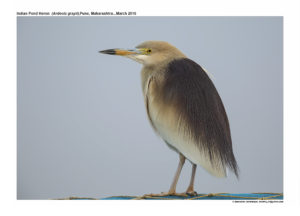Indian Pond Heron

Indian Pond Heron Ardeola grayii
Etymology:
- Ardeola : Latin word for heron derived from ardea- heron
- Grayii : Named after English ornithologist John Edward Gray (1800–1875)
Vernacular Names: Hindi: Bagla, Andha bagla, Chama bagla, Khunch bagla, Sans: Andh bak, Kash: Broku, Pun: Chhappari bagla, Bi: Bogli, Ass: Kona moochuree, Ben: Konch bak, Gond: Ral puchake, Guj: Kani bagli, Kani bagali, Mar: Vanchak, Bhura bagla, Dhokri Ori: Kantiabaga, Ta: Kulathu kokku, Kuruttu kokku, Madai katan, Madayan, Te: Guddi konga, Mal: Kulamunti, Kan: Kolada baka, Sinh: Kana kokka, Podi kokka, Mald: Hudu rabulli
Distribution in India: Wide spread resident except for Himalayas, winter visitor to central India, Western Ghats and North West India.
Description: Size of 39–46 cm; wt. of 230–276 g; wingspan of 75–90 cm. Both the sexes are alike. Its legs and feet are greenish, bill is yellow-horn with extensive black tip, lores are green and eyes are yellow. In its breeding-plumage the adult has unmarked pale sandy head, neck, breast and wing-coverts, long, broad white neck plumes, dark maroon-chestnut back and has white upperwing, rump, tail and primaries. The legs and feet can become salmon-pink during courtship, more regularly bright yellow. Its lores and bill are bluish, bill has a black tip. In non-breeding adult its head and neck are streaked buff and dark brown, lacks plumes, upperparts are drab brown. The juvenile is like non-breeding adult, but has shorter head, neck and breast feathers, spotted and not streaked breast, some dull cream shaft streaks on upperparts, some faint brown mottling on tail, and bill is darker, with maxilla sometimes all dark and mandible with yellow only at base.
Habitat: It is found in rivers, streams, lakes, marshes, paddyfields, reservoirs, tidal mudflats, mangroves and irrigated pastures; also in highly human-modified areas, nesting in towns and cities. It is found mainly in lowlands from sea-level, but recorded up to 4050 m
Food Habits: It usually feeds at the edge of ponds but make extensive use of floating vegetation such as water hyacinth to access deeper water. They may also on occasion swim on water or fish from the air and land in deeper waters. It flies low over water to drive frogs and fishes towards the shore before settling along the shoreline. They have been noted to pick up a bait like bread, dead insects etc. and drop them on the water surface to bait fishes. They primarily eat small fish, crustaceans, frogs, aquatic insects. It is found solitary or in small, loose flocks; follows ploughs, and occasionally forages commensally with other species. It feeds both day and night, but mainly in morning and late afternoon.
Breeding Habits: The breeding season begins with the onset of the monsoons. They nest in small colonies, often with other wading birds, usually on platforms of sticks in trees or shrubs. Most nests are built in large leafy trees. The nest material is collected by the male while the female builds the nest. They lay a clutch of 3-5 eggs are laid. The eggs hatch asynchronously, taking 18 to 24 days to hatch. Both parents feed the young. Fish are the main diet fed to young. Nest sites that are not disturbed may be reused year after year.